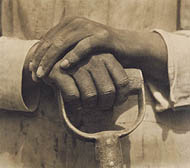Grades/Level: Upper Elementary (3–5)
Subjects: Visual Arts, English–Language Arts
Time Required: Long–Term Unit
Four to six class periods
Author: John W. Waldschmidt, Special Education Teacher, Broad Avenue Elementary, Los Angeles Unified School District
Permissions: 
The lesson plan and downloadable materials on this page are licensed under a Creative Commons Attribution 4.0 International License. |
 |
|
 |
• Fourth-grade California history textbook
• Hand tools (such as pick, shovel, hammer, ruler, saw, etc.)
• Art supplies: paper, colored pencils, crayons, watercolors
• Camera (digital camera works well)
• Pencils and writing paper |
 |
 |
 |
Two Separate Projects: 1) Man with a Hoe; 2) Hand Tools
Man with a Hoe Project:
1. Read about California agriculture in fourth grade textbook.
2. Discuss what hard work means and the physical labor required to cultivate the land.
3. Ask students about a time when they did hard physical work.
4. Have students look at the Man with a Hoe painting. What is the man doing? Why do you say that? What other things do notice about the man? What do these things tell you about him?
5. Propose that he may be working on a farm and tell students about the artist. The painter lived and worked in France. His painting tells us about the very difficult work required of people everywhere who farm and cultivate the land.
6. Students look at the pencil drawing of Man with a Hoe and compare it to the painting. Note the lack of detail in the background and how the man is standing in the foreground.
7. Students make a gesture drawing of a man holding a tool. It may be helpful for students to "warm up" by practicing gesture drawing first. Have students take turns modelling and drawing one another.
8. Students think about how this man may live after five years of hard work and discuss what they might put in the background of their drawings after the man has worked the field for five years.
9. Students make their own work of art titled "Man with a Hoe Five Years Later."
10. Students write about what the man might be thinking, saying, and/or feeling five years into the future.
11. Display completed works of art and have students share stories.
Hand Tools Project:
1. Read about California railroads in your fourth grade history textbook. Discuss the hard work and hand tools that were necessary to build the railroads.
2. View and discuss the photograph by Tina Modotti and discuss hand tools.
3. Students examine and discuss their own hands and make contour drawing of their hands.
4. Bring examples of hand tools into the classroom and discuss how they are used.
5. Students sketch a hand tool and then sketch their hands holding a tool.
6. Student look again at the photograph by Tina Modotti. Discuss the medium used for this work of art. What are some tools that artists use? What key tool might Modotti have used to make this work of art? Do you think Modotti used her hands in the same way an artist who paints or draws uses his or her hands?
7. Students find a partner and decide how to pose and take a photograph of his or her hands holding a tool.
8. Students use a camera (a digital camera works well) to photograph each other's hands holding a tool.
9. Have students develop a topic sentence about their hands as tools.
10. Students write a two-paragraph essay about their hands as tools to illustrate their photographs.
11. Students share their drawings, essays and photographs with the classroom. |
 |
 |
 |
| Hands Resting on Tool, Tina Modotti, 1927 |
 |
|
 |
Common Core Standards for English Language Arts
Grades 3–5
SPEAKING AND LISTENING
3.1 Engage effectively in a range of collaborative discussions (one-on-one, in groups, and teacher-led) with diverse partners on grade 3 topics and texts, building on others' ideas and expressing their own clearly.
3.6 Speak in complete sentences when appropriate to task and situation in order to provide requested detail or clarification. (See grade 3 Language standards 1 and 3 for specific expectations.)
4.3 Identify the reasons and evidence a speaker or media source provides to support particular points.
4.6 Differentiate between contexts that call for formal English (e.g., presenting ideas) and situations where informal discourse is appropriate (e.g., small-group discussion); use formal English when appropriate to task and situation. (See grade 4 Language standards 1 and 3 for specific expectations.)
5.1 Engage effectively in a range of collaborative discussions (one-on-one, in groups, and teacher-led) with diverse partners on grade 5 topics and texts, building on others' ideas and expressing their own clearly.
5.3 Summarize the points a speaker or media source makes and explain how each claim is supported by reasons and evidence, and identify and analyze any logical fallacies.
WRITING
3.2 Write informative/explanatory texts to examine a topic and convey ideas and information clearly.
3.4 With guidance and support from adults, produce writing in which the development and organization are appropriate to task and purpose.
4.10 Write routinely over extended time frames (time for research, reflection, and revision) and shorter time frames (a single sitting or a day or two) for a range of discipline-specific tasks, purposes, and audiences.
5.4 Produce clear and coherent writing (including multiple-paragraph texts) in which the development and organization are appropriate to task, purpose, and audience.
Visual Arts Standards for California Public Schools
Grade 4
Historical and Cultural Context
3.2 Identify and discuss the content of artworks of the past and present, focusing on the different cultures that have contributed to California's history and art heritage.
Grade 5
Creative Expression
2.0 Students apply artistic process and skills, using a variety of media to communicate meaning and intent in original artworks.
Language Arts Standards for California Public Schools
Grade 4
Writing
2.1a Relate ideas, observations, or recollections of an event or experience. |
 |
|
 |